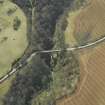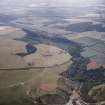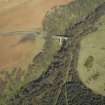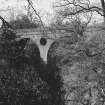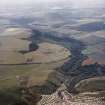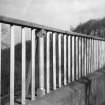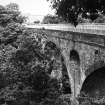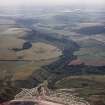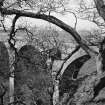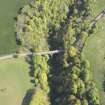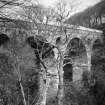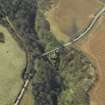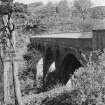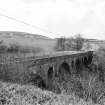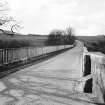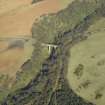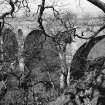Cockburnspath, Pease Bridge
Road Bridge (18th Century)
Site Name Cockburnspath, Pease Bridge
Classification Road Bridge (18th Century)
Alternative Name(s) Pease Burn; Pease Dean
Canmore ID 58739
Site Number NT76NE 30
NGR NT 79153 69977
Datum OSGB36 - NGR
Permalink http://canmore.org.uk/site/58739
- Council Scottish Borders, The
- Parish Cockburnspath
- Former Region Borders
- Former District Berwickshire
- Former County Berwickshire
NT76NE 30 79153 69977
Pease Bridge [NAT]
OS 1:10,000 map, 1977.
(NT 7915 6997) Pease Bridge was built in 1786. Comprising four tall arches, it is 300ft [91.5m] long, 16ft [4.9m] wide and 130ft [39.6m] high. The parapet is surmounted by an iron railing.
New Statistical Account (NSA, A Baird) 1845; A Thomson 1908.
Pease Bridge, 1786: David Henderson, mason/architect. Four tall arches, nearly 39m (130ft) high over the Pease Dean: the highest bridge in the world at the time of construction.
C A Strang 1994.
This bridge carries the A1107 public road over the Pease Burn to the SE of Cockburnspath village (NT77NE 65).
The location assigned to this record defines the centre of the structure. The available map evidence suggests that it extends from NT c. 79099 69967 to NT c. 79199 69972.
Information from RCAHMS (RJCM), 1 February 2006.
Construction (1783)
David Henderson designer and possible contractor
Project (2007)
This project was undertaken to input site information listed in 'Civil engineering heritage: Scotland - Lowlands and Borders' by R Paxton and J Shipway, 2007.
Publication Account (2007)
The deep gully of the Pease Burn on the former Edinburgh to Berwick turnpike road via Coldingham Moor was a
formidable obstacle to travellers prior to construction of this bridge in 1783. A strong argument in favour of building the bridge is said to have come from the military on the grounds that the gorge was almost impassable for artillery! This bridge, admired by Telford as ‘bold’ and presaging numerous tall structures of his own from the 1790s, comprises four semicircular masonry arches varying in span from 42 ft to 56 ft in roughly-squared red sandstone. It is notable for its height of about 117 ft above the burn, its slender piers and for the 9 ft diameter voids in the spandrels above each pier introduced to save weight. Most of the 3 ft high cast-iron railing surmounting each masonry parapet wall is probably contemporary or nearly so. The spandrels and parapets were extensively rebuilt in 2004.The designer was David Henderson who may also have
been the contractor.
R Paxton and S Shipway 2007
Reproduce from 'Civil Engineering heritage: Scotland - Lowlands and Borders' with kind permission of Thomas Telford Publishers.
Sbc Note (15 April 2016)
Visibility: Standing structure or monument.
Information from Scottish Borders Council



























